Introduction

Connectors consist of the following part: 1) Header pins, 2) Plug, 3) Crimp Connector, 4) Wire.
The header pins are soldered to the circuit board. There is usually one pin removed. This is the ‘key’ and it prevents the wrong plug from being used.
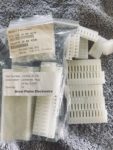
The plug is the plastic housing where the wires are inserted.
The crimp connector is the metal connector attached to the wire, then inserted into the plug housing.
The crimp itself is the act of bending part of the connector to wrap around the wire.

Most of the connections on SS Williams/ Bally / Stern / DE / Sega / Gottlieb (Sys 3) are either 0.100 (small) or 0.156 (larger) connections.
Understanding How A Crimp Connection Works
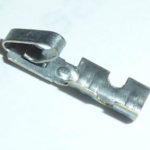
A crimp connection consists of two separate crimps: One to hold the insulation, and a second to hold the wire. The insulation is held for strength. The wire is held for the electrical connection.

When the crimp is made, the connector is wrapped or folded on these two parts of the wire. For the connection to be right, there must be enough wire stripped to just work under the inner crimp. This is important so that wire does not insert into the connection too far. Or that insulation will not be under the outer crimp. If too little wire is exposed, then the electrical connection will be poor.
For more information, visit the Molex website.
Crimper To Buy
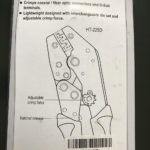

The most common crimping done in pinball is 0.100″ and 0.156″. These are the plugs that go to the circuit boards. There are instances where 0.093″ are also used, but those are mostly (but not always) plug to plug.
Pinball Life has a good selection of crimping tools. There are two tools (0.156″ for one, and 0.100″ for the other one) that are less expensive non-ratcheting tools that are good options for the person who does not do much crimping.
For crimping, if you are going to be doing this a lot, then select a ‘ratcheting‘ tool. They are easier to use and give more reliable crimps. They are not as easy to find and getting one that will do 0.156″ and 0.100″ is not easy. Pinball Life had one – in stock?
For our money, the best for the light user is the Hanlong Tools HT-225D. This has a ratchet system that is found usually only on the more expensive tools. Sadly, as of March 2023, this tool is no longer available on Amazon. There is something that looks similar with an identical part number available at Newark Electronics, but we have no experience with it. The drawings look identical to the Hanlong product, so we are hopeful. And here is the identical part number at Amazon which looks like it should work. Please let us know if you try these.
Molex crimpers are great, but expensive. They are generally available at electronics supply houses such as Newark, Mouser, Jameco, and Parts-Express.
Plug Supplies Needed:
| Note: Many of the part number reference a GPE – Great Plains Electronics part number. Sadly, GPE is shut down. These part numbers seem to be manufacturer part numbers and can be used to find alternative supplies. |
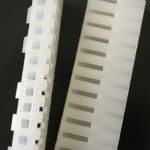
Note that there are other size connectors in your pinball machine, but these .0100 and 0.156 are the most common ones in Bally, Stern, Data East / Sega and Williams games.
Gottlieb uses edge connectors in System 1 and System 80 games. Replacing those connectors is not covered here.
Prior to starting, obtain the following supplies: header pins, plug housing, and crimp connectors.
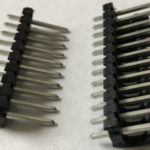
-
- Plastic plug housing Part Number: CS156-20-LR works for 20 pin 0.156. Part Number: CP100-20-LR works for 20 pin 0.100 (search “Molex 0.156” and “Molex 0.100”). Pinball Life, Marco or Big Daddy for “connectors”. Note that you do not want IDC, only Molex.
- Header pins (Either 0.156 Part Number: 26-48-1241, or 0.100 Part Number: CH100-40T-0.318). Also from Pinball Life, Marco or Big Daddy. Locking header pins are used by the manufacturer. Non-locking is fine for home use but locking might be better.
-


Trifurcon Style
0.156 crimp connectors. 22-26AWG (Part Number 08-50-0185) , and 18-20AWG wires (Part Number 08-52-0113). Pinball Life and Marco seem to have only one type and do not specify wire size. Big Daddy has a selection for smaller wire sizes. Be certain to get the Trifurcon style. - 0.100 crimp connectors (Part Number: CH100-40T-0.318) at Pinball Life or Marco.
- Polarity or Keying Plug (for the ‘key’). Part number 15-04-0297 for 0.156. Or 15-04-9209 for 0.100. Search ‘Keying Plug’. A dab of glue can be used instead, but these plugs are handy. Pinball Life and Big Daddy.

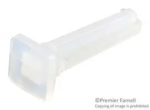
Keying or polarity plug.
Note, please install this. We have seen games literally burn because someone left out this plug. - Crimper (see ‘Crimper to Buy’, above).
There is also an extraction tool available from Marco, or search for part number: 11-03-0016 for 0.156″. This tool is handy to remove crimp connectors from a plastic plug. However, it is not too difficult to remove connectors using a small screwdriver – just crush the tab of the connector in the side slot of the plug, then pull carefully on the wire.
Also available is a kit containing most of the parts needed, Part Number: 76650-3008.
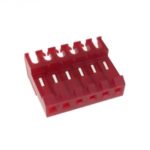

Note: Many suppliers such as Pinball Life and Marco sell IDC plugs. Those are the style originally used by most pinball manufacturers. They do not use crimping, but the wire is force inserted into a plug. It also requires a special tool or this one. We do not recommend IDC connectors.. They are less reliable than crimped connectors. However, if you have the IDC tool, these are fast to put together. Don’t try to use a screwdriver to insert the wire.
Replace the Header Pins
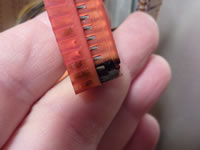

SS Pinball machines have connectors on every board. A sure sign that it is time to replace a connector is when it burns. When replacing these connectors, it is important to replace both the plug and the pins on the circuit board. If the pins on the board are not replaced, that new plug is likely to burn up again.



Replacing the pins on the board is pretty straightforward: remove the existing pins by desoldering. We find it easy to heat each pin with a soldering iron and pull each individual pin out one at a time with needle nose pliers. Then clear the solder holes with solder suckers. Insert the new pins. All done.
Crimping – Repin the Connectors


Select the proper size (0.100 or 0.156) plug housing with the correct number of holes in it. If there are too many holes, cut off the extra ones with fine wire cutters.
Next, hold the new one next to the old one and mark up the new one. We place an ‘X’ on the spots that do not get a wire, a line for where the key is located. This helps to insure that we don’t put the wire in the wrong hole. Note that the ‘key’ is where there has been a header pin removed on the circuit board. That makes it impossible to insert the wrong connector. We also like to mark the first and last position.
Next, remove one wire from the existing plug. Most plugs used by pinball manufacturers were not crimped in place. They are IDC and the wire is pushed into a pin. These are easy to remove: just pull on the wire. If a standard crimp connection, cut the wire at the plug.
Cut off a small section that is damaged. Remove the right amount of insulation to expose the proper length of bare wire (see ‘Understanding A Crimp’, above). The amount of bare wire needed is to insert far enough to reach the inside crimp. The second crimp should catch the insulation.
Grab you crimper and insert the crimp connector into the proper slot. The crimper listed above has only two slots. The smaller is for the 0.100 connector and the larger for the 0.156. Note that there is a correct direction for the connector to point. On this crimper, the wire comes in from the left.


On this ratcheting crimper, close the handle one click. This will hold the crimp connector in place (on non-ratchet crimpers, it will be necessary to hold the handle closed partially to hold the metal connector in the tool).
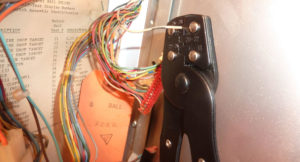

Next, insert the wire into the crimper. Insert the wire so that the stripped portion goes into the inside crimper, while the outside crimp holds the insulation (see photo ‘Anatomy of a Terminal’ above). Then squeeze the crimper. A ratchet crimper will then release. Non-ratchet crimpers will be necessary to judge the right amount of force.
Inspect the connection. If not done properly, remove and start over. Expect a high failure rate at first, but don’t get discouraged. It takes practice, especially with less expensive crimpers.


The crimp has a small tab. That keeps the connection inside the plug. Grab the new plug, carefully identify where the wire should go, and insert the wire with the crimp into the plug. Make certain that the side with the tab is facing the side of the plug with the small slots.
Once the wire and crimp is inside the plug, it should not come back out. If it does, carefully use your fingernail or small screwdriver to bend this tab further out.


At some point, you may find that what looks like a perfectly good crimp is not. After inserting the crimp into the plug, the wire comes right out. To remove the failed crimp from the plug, use a small screwdriver and, showing no mercy, smash down that tab on the plug. With some small amount of violence, it will be possible to remove the connector and try again.
Repeat one by one with each of the next wires. Be sure to follow your marking and skip the positions on the plug where there should not be a wire. By doing one at a time, you are going to make a perfect copy of the original plug and you are now an expert.
Additional Resources:
Molex Good Crimps
Clay’s Guide to Crimping
Comments
Comments, including suggestions, improvements, errors, etc. are welcome (see below).
If you have a specific question about your game that does not directly apply to crimping, please see our FAQ section.